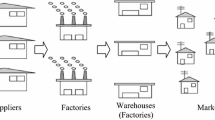Abstract
Designing a supply chain network provides the basic structure for supply chain operations, where the network is a major element in a firm's competitiveness and a significant area of capital investment. With the boundary-spanning scope encouraged by supply chain management, the question is whether existing analyses used for network design are adequate. The general answer is yes, because the number of echelons that the analysis must span is self-limiting to a relative few. However, there remain unresolved issues in network design analysis and in the models used to support the analysis that can enhance its accuracy, appropriateness, and acceptability to practitioners. Issues discussed relate to the development of better models, the treatment of the data needed by them, and the need for comparing the various models for network design.
Similar content being viewed by others
References
Ballou RH. Dynamic warehouse location. Journal of Marketing Research 1968;5(3):271–276.
Ballou RH. Estimating and auditing aggregate inventory levels at multiple stocking points. Journal of Operations Management 1981;1(3):143–153.
Ballou RH. The accuracy in estimating truck class rates for logistical planning. Transportation Research-A 1991;25A(6):327–337.
Ballou RH. Measuring transport costing error in customer aggregation for facility location. Transportation Journal 1994;33(3): 49–59.
Ballou RH. Evaluating inventory management performance using a turnover curve. International Journal of Physical Distribution and Logistics Management 2000;30(1):72–85.
Ballou RH, Rahardja H, Sakai N. Selected country circuity factors. Working Paper, Case Western Reserve University, 2000.
Ballou RH, Masters J. Commercial software for locating warehouses and other facilities. Journal of Business Logistics 1993;14(2):71–107.
Ballou RH, Masters J. Facility location commercial software survey. Journal of Business Logistics 1999;20(1):215–233.
Bender PS. Logistic system design. In: Robeson JF, House RG, eds. The Distribution Handbook.NewYork,NY: The Free Press, 1985: ch. 9.
Bookbinder JH, Reese KE. Vehicle routing considerations in distribution system design. European Journal of Operational Research 1988;37(2):204–213.
Bowersox DJ. Planning physical distribution with dynamic simulation. Journal of Marketing 1972;36(1):17–25.
Bowersox DJ, Helferich OK, Gilmour P, Morgan FW, Marien E, Lawrence ML, Rogers R. Dynamic Simulation of Physical Distribution Systems. East Lansing, MI: Michigan State University, 1972.
Brandeau ML, Chiu SS. An overview of representative problems in location research. Management Science 1989;35(6):645–674.
Drezner Z. Facility Location. New York, NY: Springer-Verlag, 1995.
Geoffrion AM, Van Roy TJ. Common sense planning methods can be hazardous to your corporate health. Sloan Management Review 1979;20(4):31–42.
Ghosh A, McLafferty SL. Location Strategies for Retail and Service Firms. Lexington, MA: D.C. Heath and Company, 1987.
Greenhut ML. Plant Location in Theory and Practice. Chapell Hill, NC: University of North Carolina Press, 1956.
Heskett JL. Spatial and temporal aspects of physical distribution. In: Bennett PD, ed. Marketing and Economic Development. Chicago: American Marketing Association, 1965:679–687.
Heskett JL. A missing link in physical distribution system design. Journal of Marketing 1966;30(A):37–41.
Ho PK, Perl J. Warehouse location under service-sensitive demand. Journal of Business Logistics 1995;16(1):133–162.
Hoover EM. Location Theory and the Shoe and Leather Industries. Cambridge, MA: Harvard University Press, 1957.
Isard W. Methods of Regional Analysis: An Introduction to Regional Science. Cambridge: Technology Press of the Massachusetts Institute of Technology and New York: Wiley, 1960.
Isard W. Location and Space Economy. Cambridge, MA: The MIT Press, 1968.
Lösch A. Die Räumliche Ordnung derWirtscaft. Jena: Gustav Fischer Verlag, 1940.
Palander T.F. Beiträge zur Standortstheorie. Upsala: Almqvist & Wiksell, 1935.
Perl J, Daskin MS. A unified warehouse location-routing methodology. Journal of Business Logistics 1984;5(1):92–111.
Shycon H. How customer service impacts sales growth and ROI and how distribution can help increase corporate success. In: Annual Proceedings of The National Council of Physical Distribution Management (Now The Council of Logistics Management, Chicago), vol. II, 1982:563–579.
Sweeney D, Tatham RL. Am improved long-run model for multiple warehouse location. Management Science 1976;22(7):748–758.
Van Roy T, Erlenkotter D. A dual-based procedure for dynamic facility location. Management Science 1982;28(10):1091–1105.
von Thünen JH. Der Isolierte Staat in Beziehung auf Landwirtschaft und Nationalökonomie, 2nd ed. Rostock, 1842; translated by Wartenburg CM, as Von Thünen's Isolated State, Hall P, ed. Oxford: Pergamon Press, 1966.
Weber A. 1909. Ñber den Standort der Industrien. Mohr, Tubingen; translated by Friedrich CJ as Alfred Weber's Theory of the Location of Industries. Chicago, IL: University of Chicago Press, 1929.
Wesolowsky GO, Truscott WG. The multi-period location-allocation problem with relocation of facilities. Management Science 1975;22:57–65.
Author information
Authors and Affiliations
Rights and permissions
About this article
Cite this article
Ballou, R.H. Unresolved Issues in Supply Chain Network Design. Information Systems Frontiers 3, 417–426 (2001). https://doi.org/10.1023/A:1012872704057
Issue Date:
DOI: https://doi.org/10.1023/A:1012872704057




